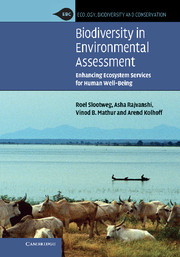Book contents
- Frontmatter
- Contents
- List of contributors
- Foreword
- Preface
- List of abbreviations
- Part I Setting the stage
- Part II Assessment tools
- 4 The impact assessment framework
- 5 Environmental assessment
- 6 Biodiversity in environmental impact assessment
- 7 Biodiversity-inclusive Strategic Environmental Assessment
- Part III Emerging issues
- Epilogue – Topics in need of further elaboration
- Annex: valuation of ecosystem services: influential cases
- References
- Index
4 - The impact assessment framework
Published online by Cambridge University Press: 05 July 2014
- Frontmatter
- Contents
- List of contributors
- Foreword
- Preface
- List of abbreviations
- Part I Setting the stage
- Part II Assessment tools
- 4 The impact assessment framework
- 5 Environmental assessment
- 6 Biodiversity in environmental impact assessment
- 7 Biodiversity-inclusive Strategic Environmental Assessment
- Part III Emerging issues
- Epilogue – Topics in need of further elaboration
- Annex: valuation of ecosystem services: influential cases
- References
- Index
Summary
Introduction
The Brundtland Report (WCED, 1987) introduced the concept of sustainable development, which has been further elaborated by the biodiversity, climate change, and antidesertification conventions created at the UNCED conference, or Earth Summit, in Rio de Janeiro in 1992. ‘Sustainable development’ as a concept is based on the idea that environment and development are intimately connected and coevolve. As a policy notion it also suggests that a positive connection between and coevolution of environment and development is possible. This was made more explicit by the adoption of the Millennium Development Goals in Johannesburg in 2000 (United Nations, 2000).
Sustainability is usually described in terms of its three pillars: (1) economy, (ii) environment, and (iii) society. This interpretation of sustainability is translated into different vocabularies, such as the ‘triple bottom line’ in sustainability appraisal, or the triple ‘P’ of people, planet, profit in corporate social responsibility. In a sense, even the objectives of the Convention on Biological Diversity (see Chapter 2) can be translated in these terms: conservation addresses planet, sustainable use relates to profit, and equitable sharing is about people.
The consequence of the desire to integrate environmental, social, and economic aspects in assessments of projects, plans, programmes, and policies is the need for an integrating framework. In practice, the worlds of environmental impact assessment (in its strict meaning of assessing biophysical impacts only), social impact assessment, and economic cost– benefit analysis largely continue to operate in their separate realms and experience great difficulty in working in a multidisciplinary environment (Slootweg et al., 2001). As Treweek (1999) indicated, the inconsistency of methodologies and the inconsistency of reporting on methodologies and results have, among other reasons, seriously hampered the accumulation of one body of relevant knowledge in the prediction of impacts that human activities have on biological diversity.
- Type
- Chapter
- Information
- Biodiversity in Environmental AssessmentEnhancing Ecosystem Services for Human Well-Being, pp. 87 - 124Publisher: Cambridge University PressPrint publication year: 2009



